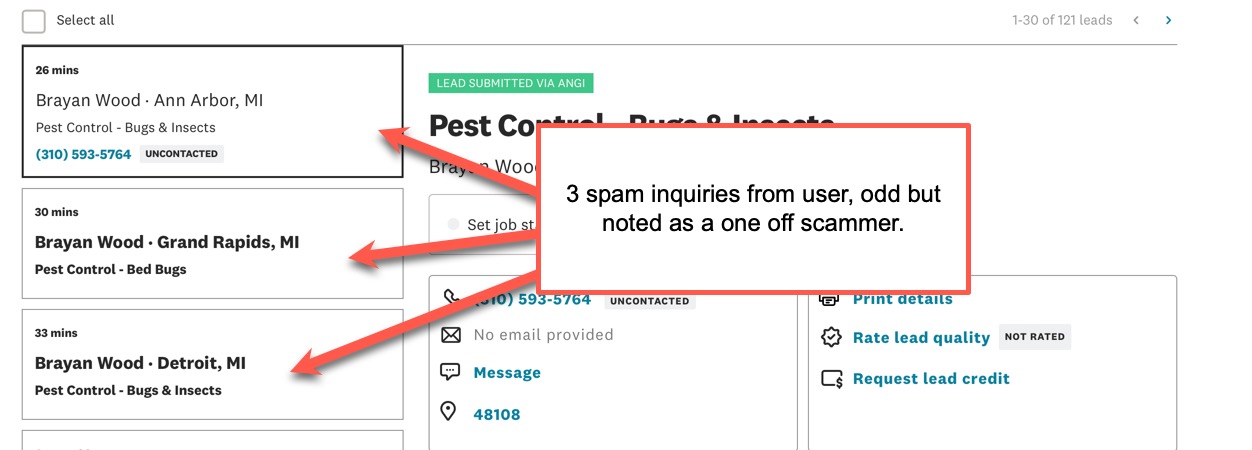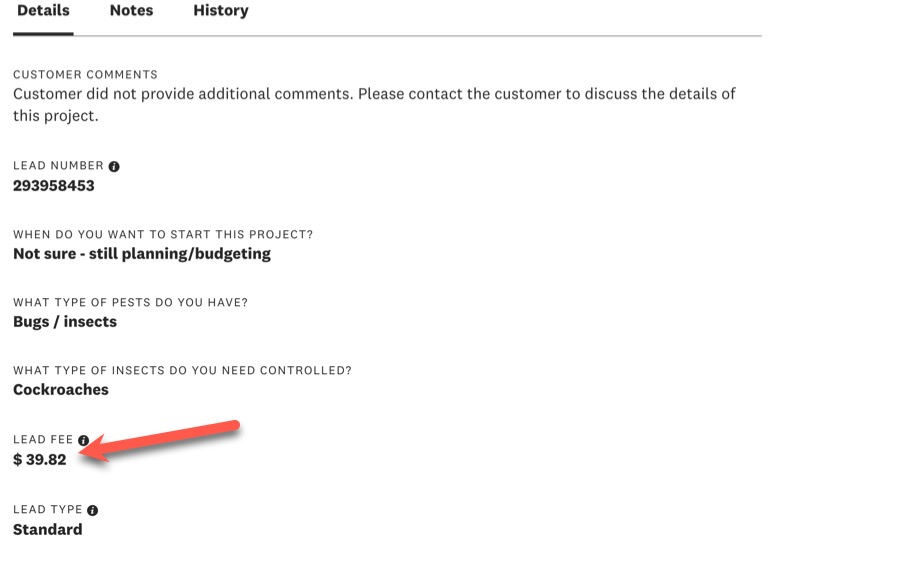
In our role, as a marketing firm handling accounts, through Angi Leads (a.k.a HomeAdvisor) platform we’ve noticed a troubling pattern that brings up significant doubts regarding the platforms reliability and validation procedures.
10 days ago is when things kicked off for us. We spotted something, in a Florida account with a batch of leads that raised our eyebrows. These three leads all went by the name “Brayan Wood”. Popped up within five minutes from totally different areas of coverage. Clearly something wasn’t right about it all we flagged them as fake. Promptly got in touch with Angi’s support team to report the situation and luckily received credit for the questionable leads. Initially brushing it off as either a lone scammer at work 0r someone trying to pull a fast, on us with the system.

The situation became more concerning yesterday when we noticed a pattern, in a Michigan based account well. Three leads were received from “Brayan Wood,” each from service areas in succession. The resemblances, between the two situations were too noticeable to overlook indicating that this was not a coincidence but a planned effort to deceive Angi users.

Seeing the perspective.
Upon inspection three counterfeit leads may not appear significant; however when you take into account that each lead carries a price tag of $40 the expenses begin to accumulate quickly. In this scenario three fake leads translate to a loss of $120. If this fraudulent activity is happening across accounts. Even hundreds or thousands. The financial consequences become quite significant.

It is alarming to see activities happening on Angi Leads despite its resources and prominent position, in the lead generation sector.
Who could be responsible, for this?
The big question here is who is pulling the strings behind all of this? It’s not crystal clear, at the moment. One thing we can say for sure is that this isn’t just a problem popping up out of nowhere. Seeing this same pattern play out in two situations across different states makes it seem like theres a bigger plan, at work here. Like someone or some group is purposefully taking advantage of the system.
The name “Brayan Wood” may not hold significance independently; however if various companies are encountering this name in leads consistently it could help us pinpoint the source of this scam more accurately.
Why is this important, in the scheme of things?
For individuals who depend on lead generation platforms such, as Angi’s Leads for their businesses growth and sustainability the importance of receiving genuine and high quality leads cannot be overstated. Wasting money and valuable time pursuing leads is detrimental to a company’s bottom line and productivity. When fraudulent activities permeate Angi’s platform it not only erodes user trust but also raises concerns, about the integrity of their validation procedures.
What We’re Inquiring About
Has anyone else using Angi Leads encountered a situation, like this before? Have you received leads from “Brayan Wood”. Observed any trends in your accounts recently? This might be happening in industries or locations with types of services involved. If you have experienced something to this scenario mentioned above. Wish to share your insights or thoughts on it with us. Feel free to reach out! We’re keen to hear from you and learn more, about your experiences.
Our aim is to gather details in order to shed light on this matter and advocate for security and measures to prevent fraud, by Angies List representatives.
Wrapping Up Ideas
Scams have always been a presence, in the lead generation realm; however it is disconcerting to witness them infiltrate a platform like Angi. A company with substantial resources and revenue streams that should theoretically be more secure, against calculated fraud schemes. It’s crucial for us to delve further into this matter and urge businesses to remain watchful and alert.
If you’ve observed any resemblances or commonalities, in your experiences recently and wish to discuss about it with me; I’m here to collaborate with you on holding platforms responsible and verifying the value of leads we invest in.
You can email me at john@webmoves.net with any information you may have.
Thanks
 Adwords by Google is a proven way to generate traffic, leads, and sales. It is a tool that some marketers are using on a regular basis to drive business goals. While there are a few using this tool to great effect, several more are striking out and in the process, throwing a lot of money out the window. Having success with Adwords calls for you to take the same approach you take to generating visibility for your organic content — optimize. However, the actual steps to optimization are a bit different in this arena.
Adwords by Google is a proven way to generate traffic, leads, and sales. It is a tool that some marketers are using on a regular basis to drive business goals. While there are a few using this tool to great effect, several more are striking out and in the process, throwing a lot of money out the window. Having success with Adwords calls for you to take the same approach you take to generating visibility for your organic content — optimize. However, the actual steps to optimization are a bit different in this arena.
1. Learn to Bid and Budget
Understanding how to bid and budget your funds is crucial to Adwords success. Spending $20 a day may appear to be the way to go for cost-conscious advertisers, but a budget that low will also limit your ability to profit. Likewise, bidding low initially can save you some money, but it might not get you very many clicks. While you don’t want to spend beyond the budget, you also don’t want to limit your potential, so learning how to manage your funds in accordance to the ad platform is key.
Facebook has done us a favor today and changed the security settings in all of our accounts. Take a look at the Facebook URL (web browser URL window) you will see http://www.facebook.com (non-secure webpage) instead of https://www.facebook.com (secure webpage) you are no longer on an encrypted secure page. I am not exactly sure why Facebook likes to make these changes, and not tell anyone? People will figure it out and then it appears as if they are being sneaky! I think they would be better off going public and telling people it will provide a better user experience, which is what everyone else does.
How to fix this? Go to Account-Account Settings – Click Security on the left top corner – click Edit next to Secure Browsing, Check box, click Save. Facebook has the default setting to a non-secure setting; needless to say this non-secure setting provides benefits to Facebook, not to its users.
Google announced the launch of Google Shopping in four new countries this week: Australia, Italy, Spain, and the Netherlands. Google Shopping is a comparison shopping engine delivering product results already in US and many other countries. Google includes products delivered to them via data feed.
Product results in US are shown directly on page one of standard search, with images, pricing, and customer ratings. This high visibility can be a large traffic force for any ecommerce business. But thus far the shopping results in the new countries are not displaying in the main results. The user must click the Shopping tab on the left to use the retail search engine, but we expect in due time Google will integrate products into page one as they have elsewhere.
This is basically free traffic and advertising, so any business shipping to these countries needs to take some action. If you already provide your data feed to Google, you just need to create a new feed and choose that country from the drop down. If you are not set up with Google Shopping yet in any country, visit the Merchant Center to open an account and set up your product feed.
With our strong presence in the Australian market, we are most excited to see this launch! We have been prepping our clients for this and ready to get them included immediately.
Also note that this makes it more important to use the hreview microformat for your customer reviews as we discussed last week.
Growing rapidly, with about 200 million registered users and estimated to surpass the 15 million adult users in the US in 2011, Twitter has proved as a very successful venture in the past 3 years. Based on acquisition offers, the company value has increased from $3.7 billion in 2009 to about $10 billion in the closing months of 2010. Yet, the owners are probably not going to sell it any time soon.
Instead, they want to turn Twitter into more profitable website. And the best way to ear money for an internet website is, of course, advertising. Currently, there are three options for advertising on Twitter – Promoted Tweets (that look like normal tweets, but are said to reach not only your followers but a significantly larger crowd), Promoted Trends (advertising at the Twitter home page) and Promoted Accounts (Twitter recommends certain accounts as “worth to follow”).
The problem, however, is that every potential advertiser has to submit an advertising request, which is then reviews by the Twitter staff and is either approved or not approved. The approval process is manual and, as a result very slow. Many small- and medium-sized businesses simply give up, unwilling to wait, and turn to other advertising options – such as Google Adwords and Facebook Ads.
Although Twitter is not going to remodel the advertising scheme completely, it is done the first step, reportedly increasing the “advertising team” to assize of 35 workers (a notable 10% of the company personnel). Their primary task will be to improve response times and also to contact potential advertisers – those who had previously expressed interest in using Twitter in their campaigns.
It was always believed that “word-to-mouth” is the best form of advertising. Before buying certain product, one would generally consult with those who already bought it, asking their opinion as well as the observed pros and cons. Advertising could make the product recognizable, but it were always the reviews that could make it a really popular hit.
With the introduction and development of the internet and the so-called “global village”, the importance of the reviews has escalated even further. When considering certain product, most of us would check what the others said about it, reasonably assuming that an unbiased opinion of the real user is more valuable than the presented specs and even professional opinions. Reading reviews before buying a product has become a mandatory (and quite easy) stage of the research.
Recently, another step in promoting this “what-do-the-users-say-about-it” way of buying has been made. A new site has been launched, called “SearchReviews”. The idea is simple – it is an Search Index (or as we call it “search engine”) that gathers reviews of various products form different online retailers (amazon, ebay etc.) and presents them as the answer to user query. The search can be a very specific (such as Nokia N95 8g) as well as fairy general (apple iPad). Currently, reviews only exist for products, but in the future SearchReviews.com owners plan to include services as well, integrating local reviews into the index.
Twitter has mad a strong progress in the recent years. It has been a useful tool both for fun and, of course, business. Respectable companies are tweeting, telling their followers about company news, promotions etc. It is only a matter of time for world’s most popular the micro-blogging platform to reach 200M registered users – the current figure being about 175 Million. People are sharing their thought and ideas using Twitter at astonishing rate, reportedly over 65M tweets per day.
Notably, according to recent research, only 50% of the tweets are in English. It seems that Twitter decided to carry on its success in the Asian market as Japanese is the second popular tweeting language and Malay is fourth with Portuguese being third due to the tool’s extreme popularity in Brazil. However, instead of addressing the challenging Chinese market, Twitter skippers have picked Korean as the seventh supported language (don’t confuse with the messages language, which can be almost anything, form Tamil to Hebrew and Arabic) in addition to the existing English, German, French, Spanish, Italian, and Japanese.
The decision is based on the amazing growth rate of South Korean Twitter users (almost ten times in 2010) and the country being relatively advanced in technological terms. The relevant iPhone app and Twitter mobile for Android in Korean have also been launched, making tweeting easier for the South Koreans.
It has only been several months since Google had announced and completed the “New Adsense” – a redesign of the familiar GUI, adding several features to impress the users. And here it is – they are already adding more attributes to the popular money-making feature.
According to recent report, there will be now more things you could do in your Google Adsense account, such as creating and editing channels in Adsense for Games and Adsense for Video, blocking specific products by names and view the reports by page, and not only by unit.
There have also been some “renames” – the HTML is now “rich media” and Dynamic Images are called “Animated Images”. All those (as well as text, image and Flash) are included in the performance reports as “Ad types”. In addition, “Ad Requests” is the term that is now used instead of “Unit Impressions”, counting each time the request to show the ad is sent by the website towards Google service.
Google hopes these updates will be beneficial to Adsense users, making the popular “monetize you website” option preferable over Affiliate marketing, specific client banners and other possibilities.now
Twitter has been here for quite a while, but it has really grown in the recent two years. And lately, with the people tweet to share their ideas and opinions as well as notify their friends (aka followers) about the current news, almost every business is using Twitter constantly for promotion offers and other valuable information.
The competition in the online world is pretty severe, and Twitter is no exception. The users need to become more and more creative to make you follow them. Another important task is preserving the follower’s base. And one the ways to achieve that is to let them share an opinion with the “big brother” – the brand. That’s what Twitter Chat is about – allow followers (aka customers) to ask questions and offer personal opinions. Although it is doubtful that any of these ideas will be actually heard in the company HQ (although some certainly might), the “round-table” definitely present a certain level of satisfaction for the clients.
Additionally, this emphasizes a very important thing in the internet era – there are actual people behind the brand. @username is not a tweeting robot; it is a living human being that can chat with you from time to time.
According to several anonymous sources, Googel is planning to launch an e-newsstand application that will run on Android tablets and smartphones in order to battle Apple’s iTunes sales.
Leading publishers, such as Time Inc and Wall Street Journal, are being approached by the not-only-biggest-Search-Engine executives in order to establish a fruitful cooperation and figure out the most beneficial way of application development. Commissions lower than those of Apple’s (30 percent) are being promised as well as various advanced buyer’s data-gathering features.
When all this is going to happen is unclear, and some doubt that the venture will launch at all – but the initiative is too important to overlook as Google looks to enter another niche.